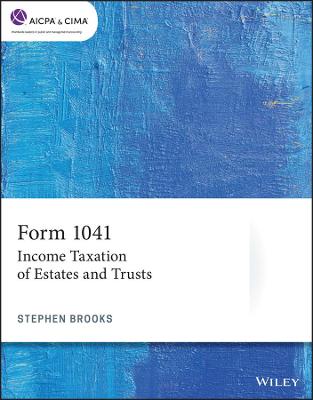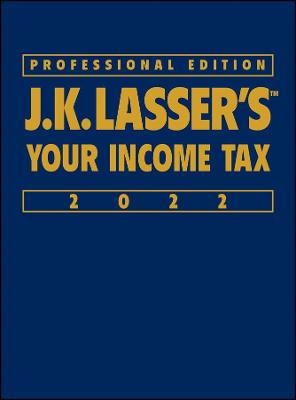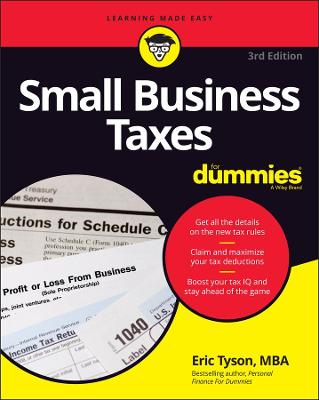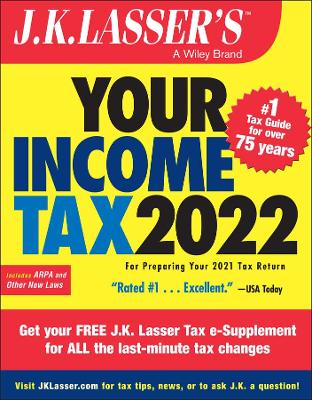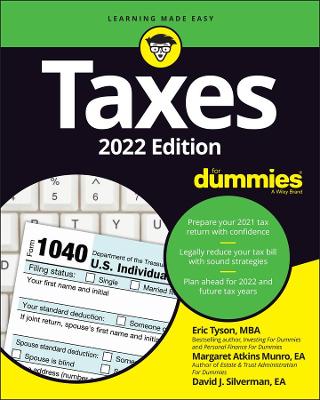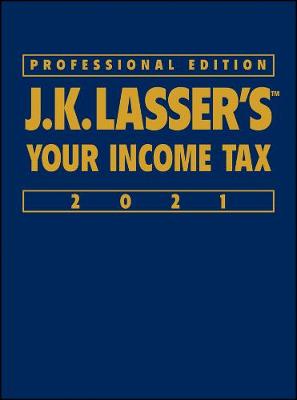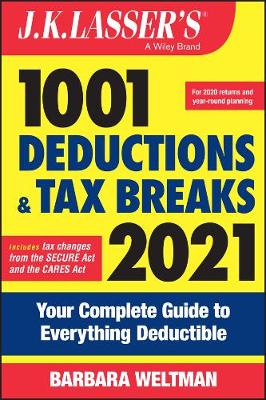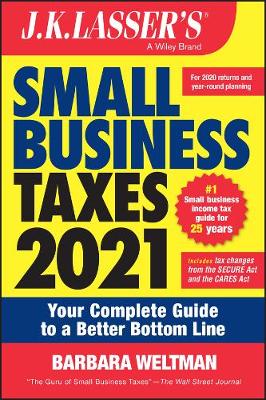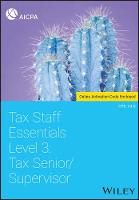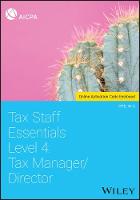Form 1041
Form 1041
Income Taxation of Estates and Trusts
John Wiley & Sons Inc
10/2020
240
Mole
Inglês
9781119763796
546
Descrição não disponível.
Chapter 1 1-1 What is a Trust? What is an Estate? 1-1 What is a trust? 1-2 Decedent's estates 1-15 Chapter 2 2-1 The Fundamentals of Fiduciary Accounting 2-1 Fiduciary accounting under the UPAIA 2-4 Distinguishing income from principal under the UPAIA 2-5 The allocation of disbursements 2-15 Practice exercise 2-1 2-25 Chapter 3 3-1 Taxation of Trusts and Decedent's Estates: An Overview 3-1 Introduction 3-2 Defining passive income 3-9 Accounting periods 3-11 Section 645 election 3-12 Accounting methods 3-13 Estimated tax 3-14 Tax identification number 3-16 Chapter 4 4-1 Gross Income for Trusts and Decedent's Estates 4-1 Items to include 4-3 Treatment of property distributed in-kind 4-6 Chapter 5 5-1 Ordinary Deductions and Credits 5-1 Trade or business expense 5-2 Income-producing activities 5-3 Interest 5-4 Taxes 5-6 Losses and bad debts 5-7 Depreciation, amortization, and depletion 5-10 Deductions and credits in respect of a decedent: Section 691(b) 5-13 Deduction for estate taxes paid: Section 691(c) 5-14 Deductions that may be allowable for estate tax purposes 5-15 Qualified business income deduction for trusts and estates 5-16 Charitable contribution deductions 5-17 Suspension of miscellaneous itemized deductions subject to the two-percent floor 5-20 Deduction in lieu of exemption 5-21 Tax credits 5-22 Chapter 6 6-1 The Income Distribution Deduction 6-1 Defining DNI 6-2 Distinguishing simple trusts from complex trusts 6-4 Section 651(a): Deduction for distributions to beneficiaries of a simple trust 6-5 Section 661(a): Deduction for distributions of complex trusts and decedent's estates 6-9 Practice exercises 6-14 Chapter 7 7-1 How Beneficiaries are Taxed 7-1 The taxation of a simple trust beneficiary 7-2 The taxation of complex trust and estate beneficiaries 7-7 Practice exercises 7-13 Chapter 8 8-1 Special Rules Round-Up 8-1 Unused deductions passed through to beneficiaries upon termination of an estate or trust 8-2 The throwback rules 8-3 Special rules applicable to Sections 661 and 662 8-5 Practice exercise 8-1 8-10 Chapter 9 9-1 The Tax Treatment of Grantor Trusts 9-1 When is a grantor treated as an owner? 9-3 Reversionary interests 9-7 Power to control beneficial enjoyment 9-9 Retention of administrative powers 9-13 Power to revoke 9-15 Income for benefit of grantor 9-16 Person other than grantor treated as substantial owner 9-18 Foreign trusts having one or more U.S. beneficiaries 9-19 Chapter 10 10-1 Taxation of Special Trusts 10-1 Pooled income funds 10-2 Electing small business trusts 10-5 Bankruptcy estates 10-11 Special rule for certain revocable trusts: Section 645 10-14 Chapter 11 11-1 Filing Form 1041: U.S. Income Tax Return for Estates and Trusts 11-1 Who must file 11-2 Method of reporting for grantor trusts 11-4 Pooled income funds 11-7 Electing small business trust 11-8 Bankruptcy estate 11-10 Other types of trusts 11-12 When to file 11-13 Who must sign 11-14 Interest and penalties 11-15 Appendix A A-1 Form 1041: U.S. Income Tax Return for Estates and Trusts A-1 Glossary Glossary 1 Index Index 1 Solutions Solutions 1 Chapter 1 Solutions 1 Chapter 2 Solutions 3 Chapter 3 Solutions 6 Chapter 4 Solutions 7 Chapter 5 Solutions 8 Chapter 6 Solutions 9 Chapter 7 Solutions 18 Chapter 8 Solutions 21 Chapter 9 Solutions 23 Chapter 10 Solutions 25 Chapter 11 Solutions 26
Este título pertence ao(s) assunto(s) indicados(s). Para ver outros títulos clique no assunto desejado.
Form 1041, Estate, Estates, Trust, Trusts, beneficiaries, grantor, administration, trustee, fiduciary, trustor, executor, ITET19
Chapter 1 1-1 What is a Trust? What is an Estate? 1-1 What is a trust? 1-2 Decedent's estates 1-15 Chapter 2 2-1 The Fundamentals of Fiduciary Accounting 2-1 Fiduciary accounting under the UPAIA 2-4 Distinguishing income from principal under the UPAIA 2-5 The allocation of disbursements 2-15 Practice exercise 2-1 2-25 Chapter 3 3-1 Taxation of Trusts and Decedent's Estates: An Overview 3-1 Introduction 3-2 Defining passive income 3-9 Accounting periods 3-11 Section 645 election 3-12 Accounting methods 3-13 Estimated tax 3-14 Tax identification number 3-16 Chapter 4 4-1 Gross Income for Trusts and Decedent's Estates 4-1 Items to include 4-3 Treatment of property distributed in-kind 4-6 Chapter 5 5-1 Ordinary Deductions and Credits 5-1 Trade or business expense 5-2 Income-producing activities 5-3 Interest 5-4 Taxes 5-6 Losses and bad debts 5-7 Depreciation, amortization, and depletion 5-10 Deductions and credits in respect of a decedent: Section 691(b) 5-13 Deduction for estate taxes paid: Section 691(c) 5-14 Deductions that may be allowable for estate tax purposes 5-15 Qualified business income deduction for trusts and estates 5-16 Charitable contribution deductions 5-17 Suspension of miscellaneous itemized deductions subject to the two-percent floor 5-20 Deduction in lieu of exemption 5-21 Tax credits 5-22 Chapter 6 6-1 The Income Distribution Deduction 6-1 Defining DNI 6-2 Distinguishing simple trusts from complex trusts 6-4 Section 651(a): Deduction for distributions to beneficiaries of a simple trust 6-5 Section 661(a): Deduction for distributions of complex trusts and decedent's estates 6-9 Practice exercises 6-14 Chapter 7 7-1 How Beneficiaries are Taxed 7-1 The taxation of a simple trust beneficiary 7-2 The taxation of complex trust and estate beneficiaries 7-7 Practice exercises 7-13 Chapter 8 8-1 Special Rules Round-Up 8-1 Unused deductions passed through to beneficiaries upon termination of an estate or trust 8-2 The throwback rules 8-3 Special rules applicable to Sections 661 and 662 8-5 Practice exercise 8-1 8-10 Chapter 9 9-1 The Tax Treatment of Grantor Trusts 9-1 When is a grantor treated as an owner? 9-3 Reversionary interests 9-7 Power to control beneficial enjoyment 9-9 Retention of administrative powers 9-13 Power to revoke 9-15 Income for benefit of grantor 9-16 Person other than grantor treated as substantial owner 9-18 Foreign trusts having one or more U.S. beneficiaries 9-19 Chapter 10 10-1 Taxation of Special Trusts 10-1 Pooled income funds 10-2 Electing small business trusts 10-5 Bankruptcy estates 10-11 Special rule for certain revocable trusts: Section 645 10-14 Chapter 11 11-1 Filing Form 1041: U.S. Income Tax Return for Estates and Trusts 11-1 Who must file 11-2 Method of reporting for grantor trusts 11-4 Pooled income funds 11-7 Electing small business trust 11-8 Bankruptcy estate 11-10 Other types of trusts 11-12 When to file 11-13 Who must sign 11-14 Interest and penalties 11-15 Appendix A A-1 Form 1041: U.S. Income Tax Return for Estates and Trusts A-1 Glossary Glossary 1 Index Index 1 Solutions Solutions 1 Chapter 1 Solutions 1 Chapter 2 Solutions 3 Chapter 3 Solutions 6 Chapter 4 Solutions 7 Chapter 5 Solutions 8 Chapter 6 Solutions 9 Chapter 7 Solutions 18 Chapter 8 Solutions 21 Chapter 9 Solutions 23 Chapter 10 Solutions 25 Chapter 11 Solutions 26
Este título pertence ao(s) assunto(s) indicados(s). Para ver outros títulos clique no assunto desejado.

